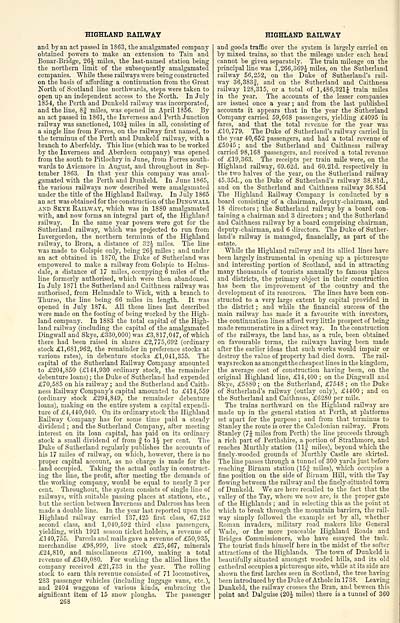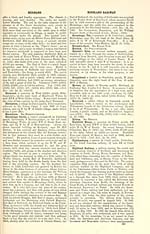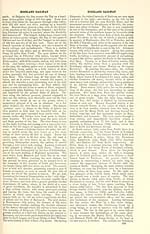Ordnance gazetteer of Scotland > Volume 4
(48) Page 268
Download files
Complete book:
Individual page:
Thumbnail gallery: Grid view | List view

HIGHLAND RAILWAY
and by an act passed in 1S63, the amalgamated company
obtained powers to make an extension to Tain and
Bonar-Bridge, 26J miles, the last-named station being
the northern limit of the subsequently amalgamated
companies. While these railways were being constructed
on the basis of affording a continuation from the Great
North of Scotland line northwards, steps were taken to
open up an independent access to the North. In July
1854, the Perth and Dunkeld railway was incorporated,
and the line, 8| miles, was opened in April 1856. By
an act passed in 1861, the Inverness and Perth Junction
railway was sanctioned, 103 \ miles in all, consisting of
a single line from Forres, on the railway first named, to
the terminus of the Perth and Dunkeld railway, with a
branch to Aberfeldy. This line (which was to be worked
by the Inverness and Aberdeen company) was opened
from the south to Pitlochry in June, from Forres south-
wards to Aviemore in August, and throughout in Sep-
tember 1863. In that year this company was amal-
gamated with the Perth and Dunkeld. In June 1865,
the various railways now described were amalgamated
under the title of the Highland Railway. In July 1865
an act was obtained for the construction of the Dingwall
and Skte Railway, which was in 1880 amalgamated
with, and now forms an integral part of, the Highland
railway. In the same year powers were got for the
Sutherland railway, which was projected to run from
Iuvergordon, the northern terminus of the Highland
railway, to Brora, a distance of 32J miles. The line
was made to Golspie only, being 26f miles ; and under
an act obtained in 1S70, the Duke of Sutherland was
empowered to make a railway from Golspie to Helms-
dale, a distance of 17 miles, occupying 6 miles of the
line formerly authorised, which were then abandoned.
In July 1871 the Sutherland and Caithness railway was
authorised, from Helmsdale to "Wick, with a branch to
Thurso, the line being 66 miles in length. It was
opened in July 1874. All these lines last described
were made on the footing of being worked by the High-
land company. In 18S3 the total capital of the High-
land railway (including the capital of the amalgamated
Dingwall and Skye, £330,000) was £3,817,047, of which
there had been raised in shares £2,775,692 (ordinary
stock £1,681,962, the remainder in preference stocks at
various rates), in debenture stocks £1,041,355. The
capital of the Sutherland Railway Company amounted
to £204,850 (£144,930 ordinary stock, the remainder
debenture loans) ; the Duke of Sutherland had expended
£70,585 on his railway ; and the Sutherland and Caith-
ness Railway Company's capital amounted to £414,559
(ordinary stock £294,849, the remainder debenture
loans), making on the entire system a capital expendi-
ture of £4,440,040. On its ordinary stock the Highland
Railway Company has for some time paid a steady
dividend ; and the Sutherland Company, after meeting
interest on its loan capital, has paid on its ordinary
stock a small dividend of from | to 1J per cent. The
Duke of Sutherland regularly publishes the accounts of
his 17 miles of railway, on which, however, there is no
proper capital account, as no charge is made for the
land, occupied. Taking the actual outlay in construct-
ing the line, the profit, after meeting the demands of
the working company, would be equal to nearly 3 per
cent. Throughout, the system consists of single line of
railways, with suitable passing places at stations, etc. ,
but the section between Inverness and Dalcross has been
made a double line. In the year last reported upon the
Highland railway carried 137,425 first class, 67,242
second class, and 1,040,592 third class passengers,
yielding, with 1921 season ticket holders, a revenue of
£140,755. Parcels and mails gave a revenue of £50,935,
merchandise £98,999, live stock £25,467, minerals
£24,810, and miscellaneous £7100, making a total
revenue of £349,080. For working the allied lines the
company received £21,733 in the year. The rolling
stock to earn this revenue consisted of 71 locomotives,
283 passenger vehicles (including luggage vans, etc.),
and 2404 waggons of various kinds, embracing the
significant item of 15 snow ploughs. The passenger
268
HIGHLAND RAILWAY
and goods traffic over the system is largely carried on
by mixed trains, so that the mileage under each head
cannot be given separately. The train mileage on the
principal line was 1,266,369^ miles, on the Sutherland
railway 56,252, on the Duke of Sutherland's rail-
way 36,383|, and on the Sutherland and Caithness
railway 128,315; or a total of 1,486,321J train miles
in the year. The accounts of the lesser companies
are issued once a year ; and from the last published
accounts it appears that in the year the Sutherland
Company carried 59,668 passengers, yielding £4095 in
fares, and that the total revenue for the year was
£10,779. The Duke of Sutherland's railway carried in
the year 40,652 passengers, and had a total revenue of
£5945 ; and the Sutherland and Caithness railway
carried 98,168 passengers, and received a total revenue
of £19,363. The receipts per train mile were, on the
Highland railway, 69.62d. and 60.21d. respectively in
the two halves of the year, on the Sutherland railway
45.35d., on the Duke of Sutherland's railway 38.81d.,
and on the Sutherland and Caithness railway 36. S5d
The Highland Railway Company is conducted by a
board consisting of a chairman, deputy-chairman, and
18 directors ; the Sutherland railway by a board con-
taining a chairman and 3 directors ; and the Sutherland
and Caithness railway by a board comprising chairman,
deputy-chairman, and 6 directors. The Duke of Suther-
land's railway is managed, financially, as part of the
estate.
While the Highland railway and its allied lines have
been largely instrumental in opening up a picturesque
and interesting portion of Scotland, and in attracting
many thousands of tourists annually to famous places
and districts, the primary object in their construction
has been the improvement of the country and the
development of its resources. The lines have been con-
structed to a very large extent by capital provided in
the district ; and while the financial success of the
main railway has made it a favourite with investors,
the continuation lines afford very little prospect of being
made remunerative in a direct way. In the construction
of the railways, the land has, as a rule, been obtained
on favourable terms, the railways having been made
after the earlier ideas that such works would impair or
destroy the value of property had died down. The rail-
ways reckon as amongstthe cheapest lines in the kingdom,
the average cost of construction having been, on the
original Highland line, £14,400 ; on the Dingwall and
Skye, £5880 ; on the Sutherland, £7548 ; on the Duke
of Sutherland's railway (outlay only), £4400 ; and on
the Sutherland and Caithness, £6280 per mile.
The trains northward on the Highland railway are
made up in the general station at Perth, at platforms
set apart for the purpose ; and from that terminus to
Stanley the route is over the Caledonian railway. From
Stanley (7^ miles from Perth) the line proceeds through
a rich part of Perthshire, a portion of Strathmore, and
reaches Murthly station (11J miles), beyond which the
finely-wooded grounds of Murthly Castle are skirted.
The line passes through a tunnel of 300 yards just before
reaching Birnam station (15J miles), which occupies a
fine position on the side of Birnam Hill, with the Tay
flowing between the railway and the finely-situated town
of Dunkeld. We are here recalled to the fact that the
valley of the Tay, wdiere we now are, is the proper gate
of the Highlands ; and in selecting this as the point at
which to break through the mountain barriers, the rail-
way simply followed the example set by all, whether
Roman invaders, military road makers like General
Wade, or the more peaceable Highland Roads and
Bridges Commissioners, who have essayed the task.
The tourist finds himself here in the midst of the softer
attractions of the Highlands. The town of Dunkeld is
beautifully situated amongst wooded hills, and its old
cathedral occupies a picturesque site, while at its side are
shown the first larches seen in Scotland, the tree having
been introduced by the Duke of Athole in 1738. Leaving
Dunkeld, the railway crosses the Bran, and beween this
point and Dalguise (20i miles) there is a tunnel of 360
and by an act passed in 1S63, the amalgamated company
obtained powers to make an extension to Tain and
Bonar-Bridge, 26J miles, the last-named station being
the northern limit of the subsequently amalgamated
companies. While these railways were being constructed
on the basis of affording a continuation from the Great
North of Scotland line northwards, steps were taken to
open up an independent access to the North. In July
1854, the Perth and Dunkeld railway was incorporated,
and the line, 8| miles, was opened in April 1856. By
an act passed in 1861, the Inverness and Perth Junction
railway was sanctioned, 103 \ miles in all, consisting of
a single line from Forres, on the railway first named, to
the terminus of the Perth and Dunkeld railway, with a
branch to Aberfeldy. This line (which was to be worked
by the Inverness and Aberdeen company) was opened
from the south to Pitlochry in June, from Forres south-
wards to Aviemore in August, and throughout in Sep-
tember 1863. In that year this company was amal-
gamated with the Perth and Dunkeld. In June 1865,
the various railways now described were amalgamated
under the title of the Highland Railway. In July 1865
an act was obtained for the construction of the Dingwall
and Skte Railway, which was in 1880 amalgamated
with, and now forms an integral part of, the Highland
railway. In the same year powers were got for the
Sutherland railway, which was projected to run from
Iuvergordon, the northern terminus of the Highland
railway, to Brora, a distance of 32J miles. The line
was made to Golspie only, being 26f miles ; and under
an act obtained in 1S70, the Duke of Sutherland was
empowered to make a railway from Golspie to Helms-
dale, a distance of 17 miles, occupying 6 miles of the
line formerly authorised, which were then abandoned.
In July 1871 the Sutherland and Caithness railway was
authorised, from Helmsdale to "Wick, with a branch to
Thurso, the line being 66 miles in length. It was
opened in July 1874. All these lines last described
were made on the footing of being worked by the High-
land company. In 18S3 the total capital of the High-
land railway (including the capital of the amalgamated
Dingwall and Skye, £330,000) was £3,817,047, of which
there had been raised in shares £2,775,692 (ordinary
stock £1,681,962, the remainder in preference stocks at
various rates), in debenture stocks £1,041,355. The
capital of the Sutherland Railway Company amounted
to £204,850 (£144,930 ordinary stock, the remainder
debenture loans) ; the Duke of Sutherland had expended
£70,585 on his railway ; and the Sutherland and Caith-
ness Railway Company's capital amounted to £414,559
(ordinary stock £294,849, the remainder debenture
loans), making on the entire system a capital expendi-
ture of £4,440,040. On its ordinary stock the Highland
Railway Company has for some time paid a steady
dividend ; and the Sutherland Company, after meeting
interest on its loan capital, has paid on its ordinary
stock a small dividend of from | to 1J per cent. The
Duke of Sutherland regularly publishes the accounts of
his 17 miles of railway, on which, however, there is no
proper capital account, as no charge is made for the
land, occupied. Taking the actual outlay in construct-
ing the line, the profit, after meeting the demands of
the working company, would be equal to nearly 3 per
cent. Throughout, the system consists of single line of
railways, with suitable passing places at stations, etc. ,
but the section between Inverness and Dalcross has been
made a double line. In the year last reported upon the
Highland railway carried 137,425 first class, 67,242
second class, and 1,040,592 third class passengers,
yielding, with 1921 season ticket holders, a revenue of
£140,755. Parcels and mails gave a revenue of £50,935,
merchandise £98,999, live stock £25,467, minerals
£24,810, and miscellaneous £7100, making a total
revenue of £349,080. For working the allied lines the
company received £21,733 in the year. The rolling
stock to earn this revenue consisted of 71 locomotives,
283 passenger vehicles (including luggage vans, etc.),
and 2404 waggons of various kinds, embracing the
significant item of 15 snow ploughs. The passenger
268
HIGHLAND RAILWAY
and goods traffic over the system is largely carried on
by mixed trains, so that the mileage under each head
cannot be given separately. The train mileage on the
principal line was 1,266,369^ miles, on the Sutherland
railway 56,252, on the Duke of Sutherland's rail-
way 36,383|, and on the Sutherland and Caithness
railway 128,315; or a total of 1,486,321J train miles
in the year. The accounts of the lesser companies
are issued once a year ; and from the last published
accounts it appears that in the year the Sutherland
Company carried 59,668 passengers, yielding £4095 in
fares, and that the total revenue for the year was
£10,779. The Duke of Sutherland's railway carried in
the year 40,652 passengers, and had a total revenue of
£5945 ; and the Sutherland and Caithness railway
carried 98,168 passengers, and received a total revenue
of £19,363. The receipts per train mile were, on the
Highland railway, 69.62d. and 60.21d. respectively in
the two halves of the year, on the Sutherland railway
45.35d., on the Duke of Sutherland's railway 38.81d.,
and on the Sutherland and Caithness railway 36. S5d
The Highland Railway Company is conducted by a
board consisting of a chairman, deputy-chairman, and
18 directors ; the Sutherland railway by a board con-
taining a chairman and 3 directors ; and the Sutherland
and Caithness railway by a board comprising chairman,
deputy-chairman, and 6 directors. The Duke of Suther-
land's railway is managed, financially, as part of the
estate.
While the Highland railway and its allied lines have
been largely instrumental in opening up a picturesque
and interesting portion of Scotland, and in attracting
many thousands of tourists annually to famous places
and districts, the primary object in their construction
has been the improvement of the country and the
development of its resources. The lines have been con-
structed to a very large extent by capital provided in
the district ; and while the financial success of the
main railway has made it a favourite with investors,
the continuation lines afford very little prospect of being
made remunerative in a direct way. In the construction
of the railways, the land has, as a rule, been obtained
on favourable terms, the railways having been made
after the earlier ideas that such works would impair or
destroy the value of property had died down. The rail-
ways reckon as amongstthe cheapest lines in the kingdom,
the average cost of construction having been, on the
original Highland line, £14,400 ; on the Dingwall and
Skye, £5880 ; on the Sutherland, £7548 ; on the Duke
of Sutherland's railway (outlay only), £4400 ; and on
the Sutherland and Caithness, £6280 per mile.
The trains northward on the Highland railway are
made up in the general station at Perth, at platforms
set apart for the purpose ; and from that terminus to
Stanley the route is over the Caledonian railway. From
Stanley (7^ miles from Perth) the line proceeds through
a rich part of Perthshire, a portion of Strathmore, and
reaches Murthly station (11J miles), beyond which the
finely-wooded grounds of Murthly Castle are skirted.
The line passes through a tunnel of 300 yards just before
reaching Birnam station (15J miles), which occupies a
fine position on the side of Birnam Hill, with the Tay
flowing between the railway and the finely-situated town
of Dunkeld. We are here recalled to the fact that the
valley of the Tay, wdiere we now are, is the proper gate
of the Highlands ; and in selecting this as the point at
which to break through the mountain barriers, the rail-
way simply followed the example set by all, whether
Roman invaders, military road makers like General
Wade, or the more peaceable Highland Roads and
Bridges Commissioners, who have essayed the task.
The tourist finds himself here in the midst of the softer
attractions of the Highlands. The town of Dunkeld is
beautifully situated amongst wooded hills, and its old
cathedral occupies a picturesque site, while at its side are
shown the first larches seen in Scotland, the tree having
been introduced by the Duke of Athole in 1738. Leaving
Dunkeld, the railway crosses the Bran, and beween this
point and Dalguise (20i miles) there is a tunnel of 360
Set display mode to: Large image | Transcription
Images and transcriptions on this page, including medium image downloads, may be used under the Creative Commons Attribution 4.0 International Licence unless otherwise stated. ![]()
| Gazetteers of Scotland, 1803-1901 > Ordnance gazetteer of Scotland > Volume 4 > (48) Page 268 |
|---|
| Permanent URL | https://digital.nls.uk/97380922 |
|---|
| Attribution and copyright: |
|
|---|---|

